Analysis of Professional Identity in Nursing: Mary's Case Study
VerifiedAdded on 2022/09/17
|8
|2116
|11
Essay
AI Summary
This essay examines a case study involving Mary, a registered nurse whose actions are assessed against the Nursing and Midwifery Board of Australia (NMBA) standards. The essay argues that Mary's behavior, including unsafe working habits and a failure to provide patient-centered care, constitutes a violation of these standards. It explores the importance of therapeutic relationships, effective communication, and adherence to ethical guidelines. The analysis highlights the significance of patient-centered care, the nurse-patient relationship, and the role of colleagues in addressing professional misconduct. The essay emphasizes the benefits of upholding clients’ expectations, effective communication, collaboration, and the role of peers and supervisors in supporting Mary to improve her practices. The essay references key literature and the NMBA Code of Conduct and Registered Nurse Standards for Practice to support its claims, concluding that Mary's colleagues are mandated to report the issue to ensure Mary can regain the capabilities to deliver ethical and professional care.
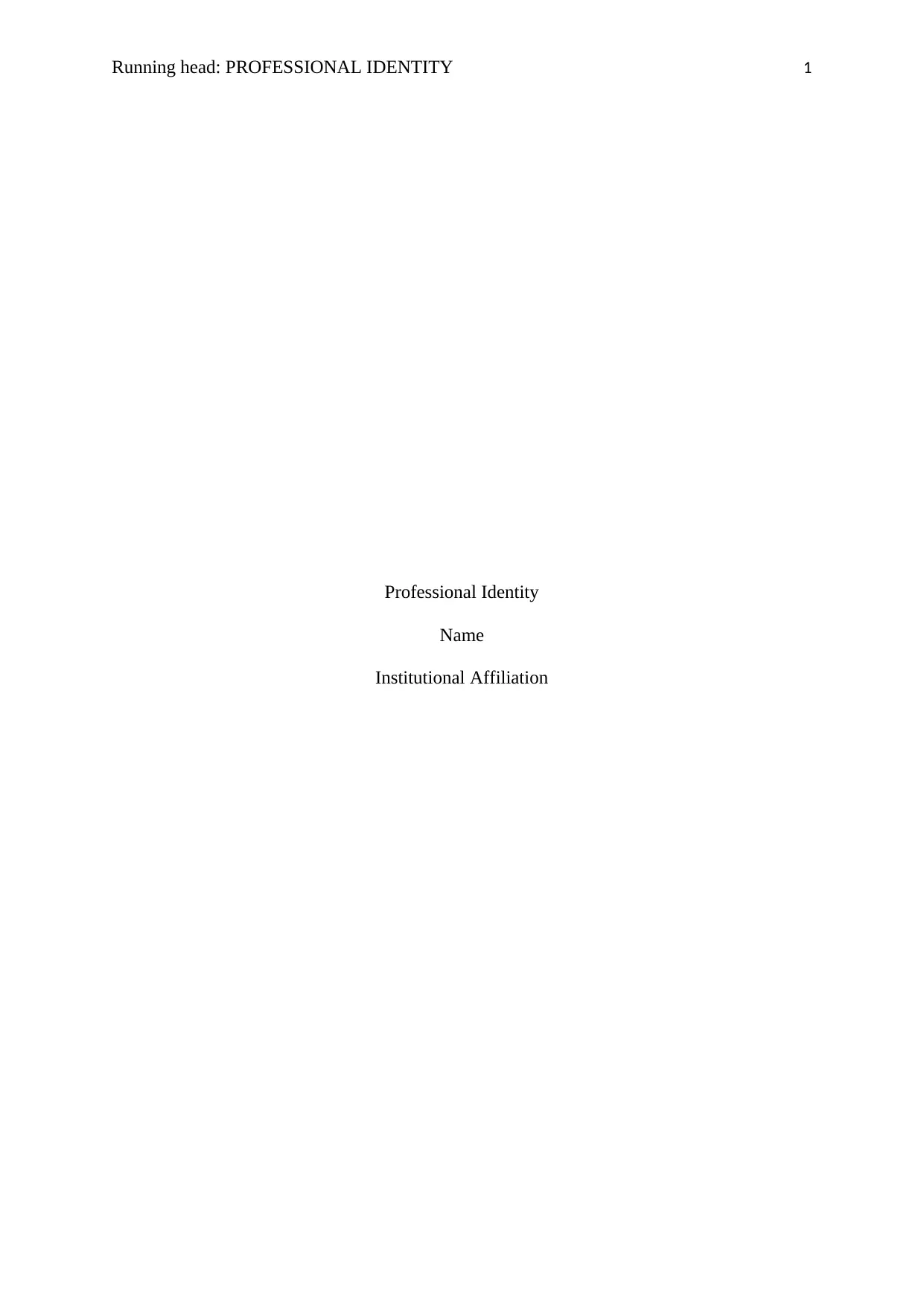
Running head: PROFESSIONAL IDENTITY 1
Professional Identity
Name
Institutional Affiliation
Professional Identity
Name
Institutional Affiliation
Paraphrase This Document
Need a fresh take? Get an instant paraphrase of this document with our AI Paraphraser
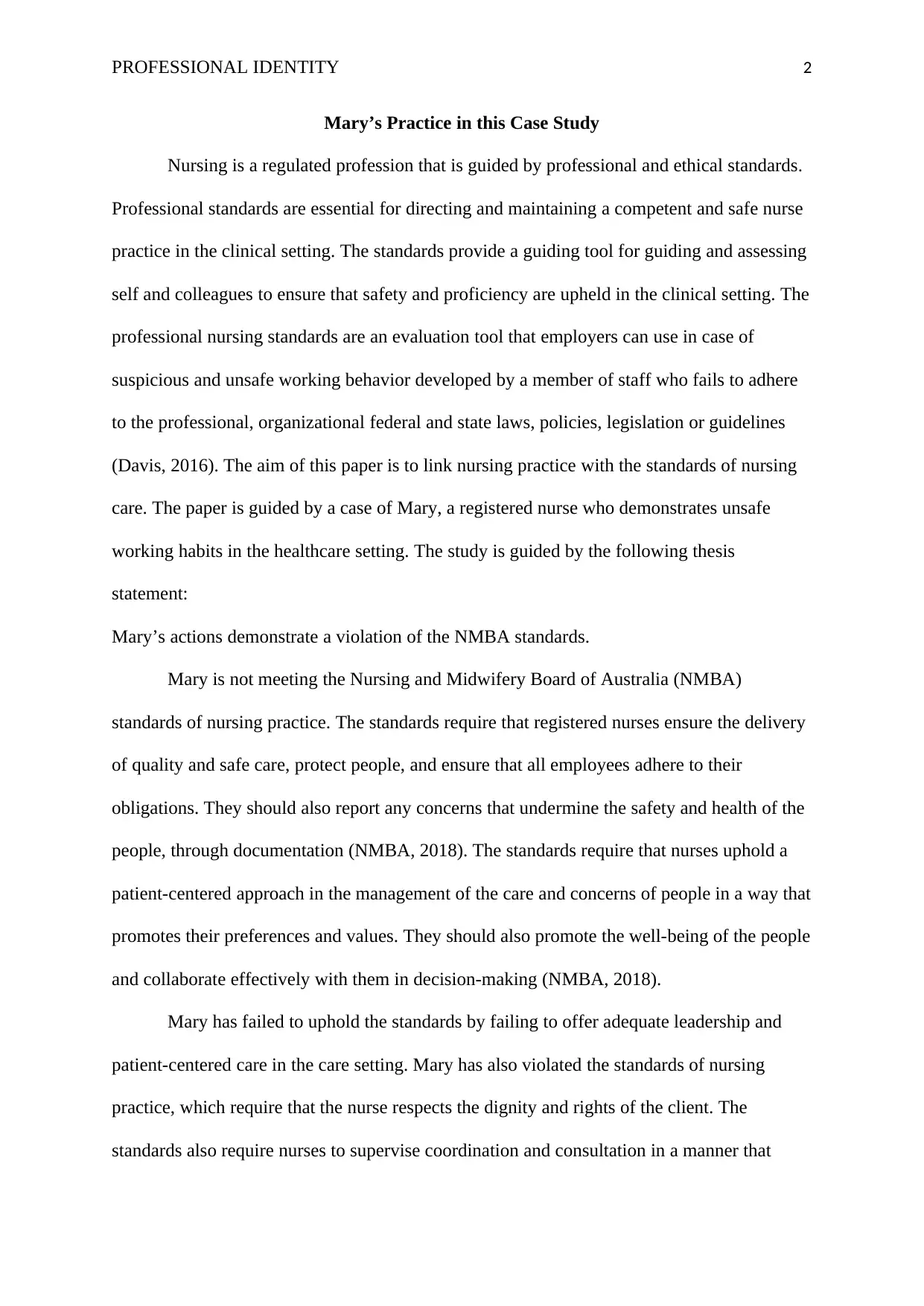
PROFESSIONAL IDENTITY 2
Mary’s Practice in this Case Study
Nursing is a regulated profession that is guided by professional and ethical standards.
Professional standards are essential for directing and maintaining a competent and safe nurse
practice in the clinical setting. The standards provide a guiding tool for guiding and assessing
self and colleagues to ensure that safety and proficiency are upheld in the clinical setting. The
professional nursing standards are an evaluation tool that employers can use in case of
suspicious and unsafe working behavior developed by a member of staff who fails to adhere
to the professional, organizational federal and state laws, policies, legislation or guidelines
(Davis, 2016). The aim of this paper is to link nursing practice with the standards of nursing
care. The paper is guided by a case of Mary, a registered nurse who demonstrates unsafe
working habits in the healthcare setting. The study is guided by the following thesis
statement:
Mary’s actions demonstrate a violation of the NMBA standards.
Mary is not meeting the Nursing and Midwifery Board of Australia (NMBA)
standards of nursing practice. The standards require that registered nurses ensure the delivery
of quality and safe care, protect people, and ensure that all employees adhere to their
obligations. They should also report any concerns that undermine the safety and health of the
people, through documentation (NMBA, 2018). The standards require that nurses uphold a
patient-centered approach in the management of the care and concerns of people in a way that
promotes their preferences and values. They should also promote the well-being of the people
and collaborate effectively with them in decision-making (NMBA, 2018).
Mary has failed to uphold the standards by failing to offer adequate leadership and
patient-centered care in the care setting. Mary has also violated the standards of nursing
practice, which require that the nurse respects the dignity and rights of the client. The
standards also require nurses to supervise coordination and consultation in a manner that
Mary’s Practice in this Case Study
Nursing is a regulated profession that is guided by professional and ethical standards.
Professional standards are essential for directing and maintaining a competent and safe nurse
practice in the clinical setting. The standards provide a guiding tool for guiding and assessing
self and colleagues to ensure that safety and proficiency are upheld in the clinical setting. The
professional nursing standards are an evaluation tool that employers can use in case of
suspicious and unsafe working behavior developed by a member of staff who fails to adhere
to the professional, organizational federal and state laws, policies, legislation or guidelines
(Davis, 2016). The aim of this paper is to link nursing practice with the standards of nursing
care. The paper is guided by a case of Mary, a registered nurse who demonstrates unsafe
working habits in the healthcare setting. The study is guided by the following thesis
statement:
Mary’s actions demonstrate a violation of the NMBA standards.
Mary is not meeting the Nursing and Midwifery Board of Australia (NMBA)
standards of nursing practice. The standards require that registered nurses ensure the delivery
of quality and safe care, protect people, and ensure that all employees adhere to their
obligations. They should also report any concerns that undermine the safety and health of the
people, through documentation (NMBA, 2018). The standards require that nurses uphold a
patient-centered approach in the management of the care and concerns of people in a way that
promotes their preferences and values. They should also promote the well-being of the people
and collaborate effectively with them in decision-making (NMBA, 2018).
Mary has failed to uphold the standards by failing to offer adequate leadership and
patient-centered care in the care setting. Mary has also violated the standards of nursing
practice, which require that the nurse respects the dignity and rights of the client. The
standards also require nurses to supervise coordination and consultation in a manner that

PROFESSIONAL IDENTITY 3
results in improved health outcomes (NMBA, 2016). Jo Delaney (2018) cited that patient-
centred care emphasizes communication and collaborative decision-making. Patient-centred
care improved healthcare outcomes and patient satisfaction. In Mary’s case, the place is
untidy, and most of the tasks such as cleaning are undone at the end of her shift. Also, the
residents assigned to her are unattended, and Mary is unavailable as she spends most of the
time away from the residents. Mary has failed to deliver patient-centred care and to act
according to the best interest of the residents. This has resulted in poor healthcare outcomes.
Based on the current evidence, Mary has failed to foster therapeutic and person-
centred relationships with the clients. Haugan (2014) posited that nurse-patient interactions
are essential in enhancing the well-being of patients. The interactions guide the way the
patient draw meaning and purpose in life. Meaningful interactions also enhance the physical
psycho-spiritual and mental well-being and functioning of the patients. Haugan (2014)
recommended that nurses need to focus on nurse-patient interactions as a critical resource.
The interactions are achieved through effective communication, self-reflection, and
connectedness with the patients. Mary is unable to integrate these concepts in her practice;
hence failing to establish patient-centred relationships.
Mary can ensure person-centred care and therapeutic relationships by understanding
the expectations of the patients and striving to accomplish them. Wiechula et al. (2015)
pointed out that patients expect that the nurses are compassionate, caring, competent, and
trustworthy. The caring attitudes and behaviours of nurses determine patients’ judgment on
the quality of their interactions and relationships. The nurses need to uphold the clients’
expectations. Communication is critical in enhancing meaningful nurse-patient relationships
(Wiechula et al., 2015). Generally, Mary should effectively communicate with the patient and
colleagues to obtain support in addressing her personal issues while meeting the needs of the
clients.
results in improved health outcomes (NMBA, 2016). Jo Delaney (2018) cited that patient-
centred care emphasizes communication and collaborative decision-making. Patient-centred
care improved healthcare outcomes and patient satisfaction. In Mary’s case, the place is
untidy, and most of the tasks such as cleaning are undone at the end of her shift. Also, the
residents assigned to her are unattended, and Mary is unavailable as she spends most of the
time away from the residents. Mary has failed to deliver patient-centred care and to act
according to the best interest of the residents. This has resulted in poor healthcare outcomes.
Based on the current evidence, Mary has failed to foster therapeutic and person-
centred relationships with the clients. Haugan (2014) posited that nurse-patient interactions
are essential in enhancing the well-being of patients. The interactions guide the way the
patient draw meaning and purpose in life. Meaningful interactions also enhance the physical
psycho-spiritual and mental well-being and functioning of the patients. Haugan (2014)
recommended that nurses need to focus on nurse-patient interactions as a critical resource.
The interactions are achieved through effective communication, self-reflection, and
connectedness with the patients. Mary is unable to integrate these concepts in her practice;
hence failing to establish patient-centred relationships.
Mary can ensure person-centred care and therapeutic relationships by understanding
the expectations of the patients and striving to accomplish them. Wiechula et al. (2015)
pointed out that patients expect that the nurses are compassionate, caring, competent, and
trustworthy. The caring attitudes and behaviours of nurses determine patients’ judgment on
the quality of their interactions and relationships. The nurses need to uphold the clients’
expectations. Communication is critical in enhancing meaningful nurse-patient relationships
(Wiechula et al., 2015). Generally, Mary should effectively communicate with the patient and
colleagues to obtain support in addressing her personal issues while meeting the needs of the
clients.
⊘ This is a preview!⊘
Do you want full access?
Subscribe today to unlock all pages.

Trusted by 1+ million students worldwide
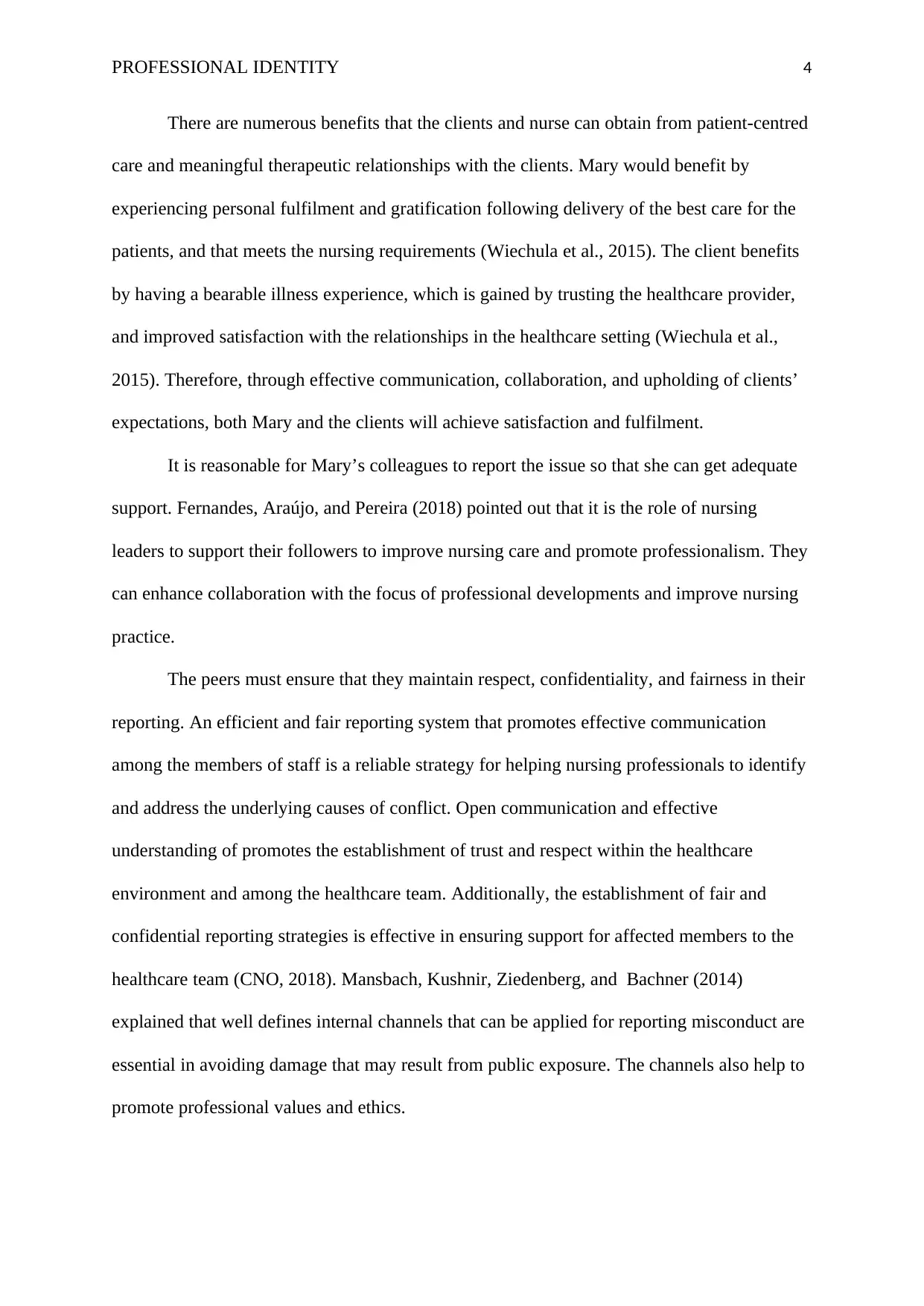
PROFESSIONAL IDENTITY 4
There are numerous benefits that the clients and nurse can obtain from patient-centred
care and meaningful therapeutic relationships with the clients. Mary would benefit by
experiencing personal fulfilment and gratification following delivery of the best care for the
patients, and that meets the nursing requirements (Wiechula et al., 2015). The client benefits
by having a bearable illness experience, which is gained by trusting the healthcare provider,
and improved satisfaction with the relationships in the healthcare setting (Wiechula et al.,
2015). Therefore, through effective communication, collaboration, and upholding of clients’
expectations, both Mary and the clients will achieve satisfaction and fulfilment.
It is reasonable for Mary’s colleagues to report the issue so that she can get adequate
support. Fernandes, Araújo, and Pereira (2018) pointed out that it is the role of nursing
leaders to support their followers to improve nursing care and promote professionalism. They
can enhance collaboration with the focus of professional developments and improve nursing
practice.
The peers must ensure that they maintain respect, confidentiality, and fairness in their
reporting. An efficient and fair reporting system that promotes effective communication
among the members of staff is a reliable strategy for helping nursing professionals to identify
and address the underlying causes of conflict. Open communication and effective
understanding of promotes the establishment of trust and respect within the healthcare
environment and among the healthcare team. Additionally, the establishment of fair and
confidential reporting strategies is effective in ensuring support for affected members to the
healthcare team (CNO, 2018). Mansbach, Kushnir, Ziedenberg, and Bachner (2014)
explained that well defines internal channels that can be applied for reporting misconduct are
essential in avoiding damage that may result from public exposure. The channels also help to
promote professional values and ethics.
There are numerous benefits that the clients and nurse can obtain from patient-centred
care and meaningful therapeutic relationships with the clients. Mary would benefit by
experiencing personal fulfilment and gratification following delivery of the best care for the
patients, and that meets the nursing requirements (Wiechula et al., 2015). The client benefits
by having a bearable illness experience, which is gained by trusting the healthcare provider,
and improved satisfaction with the relationships in the healthcare setting (Wiechula et al.,
2015). Therefore, through effective communication, collaboration, and upholding of clients’
expectations, both Mary and the clients will achieve satisfaction and fulfilment.
It is reasonable for Mary’s colleagues to report the issue so that she can get adequate
support. Fernandes, Araújo, and Pereira (2018) pointed out that it is the role of nursing
leaders to support their followers to improve nursing care and promote professionalism. They
can enhance collaboration with the focus of professional developments and improve nursing
practice.
The peers must ensure that they maintain respect, confidentiality, and fairness in their
reporting. An efficient and fair reporting system that promotes effective communication
among the members of staff is a reliable strategy for helping nursing professionals to identify
and address the underlying causes of conflict. Open communication and effective
understanding of promotes the establishment of trust and respect within the healthcare
environment and among the healthcare team. Additionally, the establishment of fair and
confidential reporting strategies is effective in ensuring support for affected members to the
healthcare team (CNO, 2018). Mansbach, Kushnir, Ziedenberg, and Bachner (2014)
explained that well defines internal channels that can be applied for reporting misconduct are
essential in avoiding damage that may result from public exposure. The channels also help to
promote professional values and ethics.
Paraphrase This Document
Need a fresh take? Get an instant paraphrase of this document with our AI Paraphraser
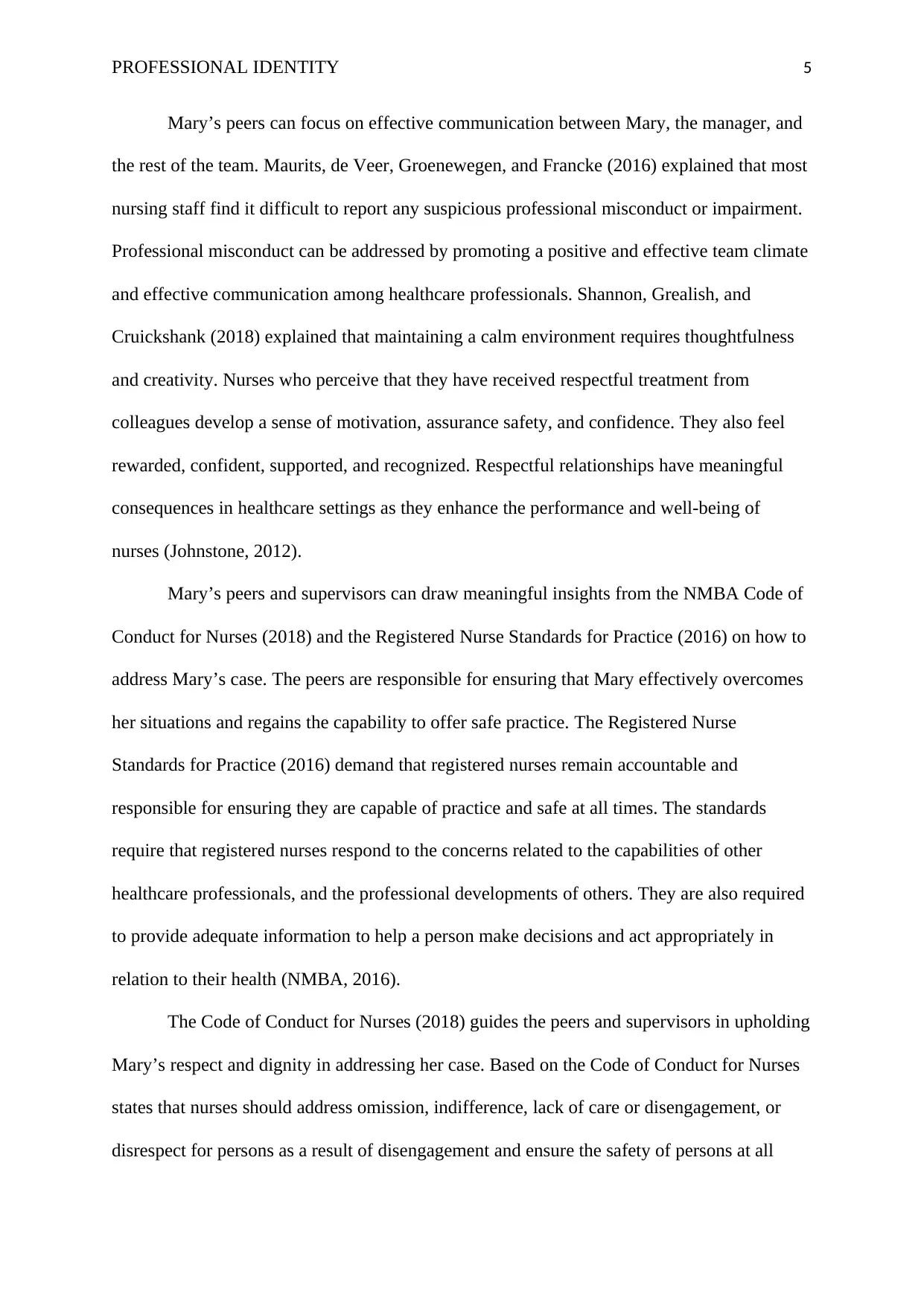
PROFESSIONAL IDENTITY 5
Mary’s peers can focus on effective communication between Mary, the manager, and
the rest of the team. Maurits, de Veer, Groenewegen, and Francke (2016) explained that most
nursing staff find it difficult to report any suspicious professional misconduct or impairment.
Professional misconduct can be addressed by promoting a positive and effective team climate
and effective communication among healthcare professionals. Shannon, Grealish, and
Cruickshank (2018) explained that maintaining a calm environment requires thoughtfulness
and creativity. Nurses who perceive that they have received respectful treatment from
colleagues develop a sense of motivation, assurance safety, and confidence. They also feel
rewarded, confident, supported, and recognized. Respectful relationships have meaningful
consequences in healthcare settings as they enhance the performance and well-being of
nurses (Johnstone, 2012).
Mary’s peers and supervisors can draw meaningful insights from the NMBA Code of
Conduct for Nurses (2018) and the Registered Nurse Standards for Practice (2016) on how to
address Mary’s case. The peers are responsible for ensuring that Mary effectively overcomes
her situations and regains the capability to offer safe practice. The Registered Nurse
Standards for Practice (2016) demand that registered nurses remain accountable and
responsible for ensuring they are capable of practice and safe at all times. The standards
require that registered nurses respond to the concerns related to the capabilities of other
healthcare professionals, and the professional developments of others. They are also required
to provide adequate information to help a person make decisions and act appropriately in
relation to their health (NMBA, 2016).
The Code of Conduct for Nurses (2018) guides the peers and supervisors in upholding
Mary’s respect and dignity in addressing her case. Based on the Code of Conduct for Nurses
states that nurses should address omission, indifference, lack of care or disengagement, or
disrespect for persons as a result of disengagement and ensure the safety of persons at all
Mary’s peers can focus on effective communication between Mary, the manager, and
the rest of the team. Maurits, de Veer, Groenewegen, and Francke (2016) explained that most
nursing staff find it difficult to report any suspicious professional misconduct or impairment.
Professional misconduct can be addressed by promoting a positive and effective team climate
and effective communication among healthcare professionals. Shannon, Grealish, and
Cruickshank (2018) explained that maintaining a calm environment requires thoughtfulness
and creativity. Nurses who perceive that they have received respectful treatment from
colleagues develop a sense of motivation, assurance safety, and confidence. They also feel
rewarded, confident, supported, and recognized. Respectful relationships have meaningful
consequences in healthcare settings as they enhance the performance and well-being of
nurses (Johnstone, 2012).
Mary’s peers and supervisors can draw meaningful insights from the NMBA Code of
Conduct for Nurses (2018) and the Registered Nurse Standards for Practice (2016) on how to
address Mary’s case. The peers are responsible for ensuring that Mary effectively overcomes
her situations and regains the capability to offer safe practice. The Registered Nurse
Standards for Practice (2016) demand that registered nurses remain accountable and
responsible for ensuring they are capable of practice and safe at all times. The standards
require that registered nurses respond to the concerns related to the capabilities of other
healthcare professionals, and the professional developments of others. They are also required
to provide adequate information to help a person make decisions and act appropriately in
relation to their health (NMBA, 2016).
The Code of Conduct for Nurses (2018) guides the peers and supervisors in upholding
Mary’s respect and dignity in addressing her case. Based on the Code of Conduct for Nurses
states that nurses should address omission, indifference, lack of care or disengagement, or
disrespect for persons as a result of disengagement and ensure the safety of persons at all
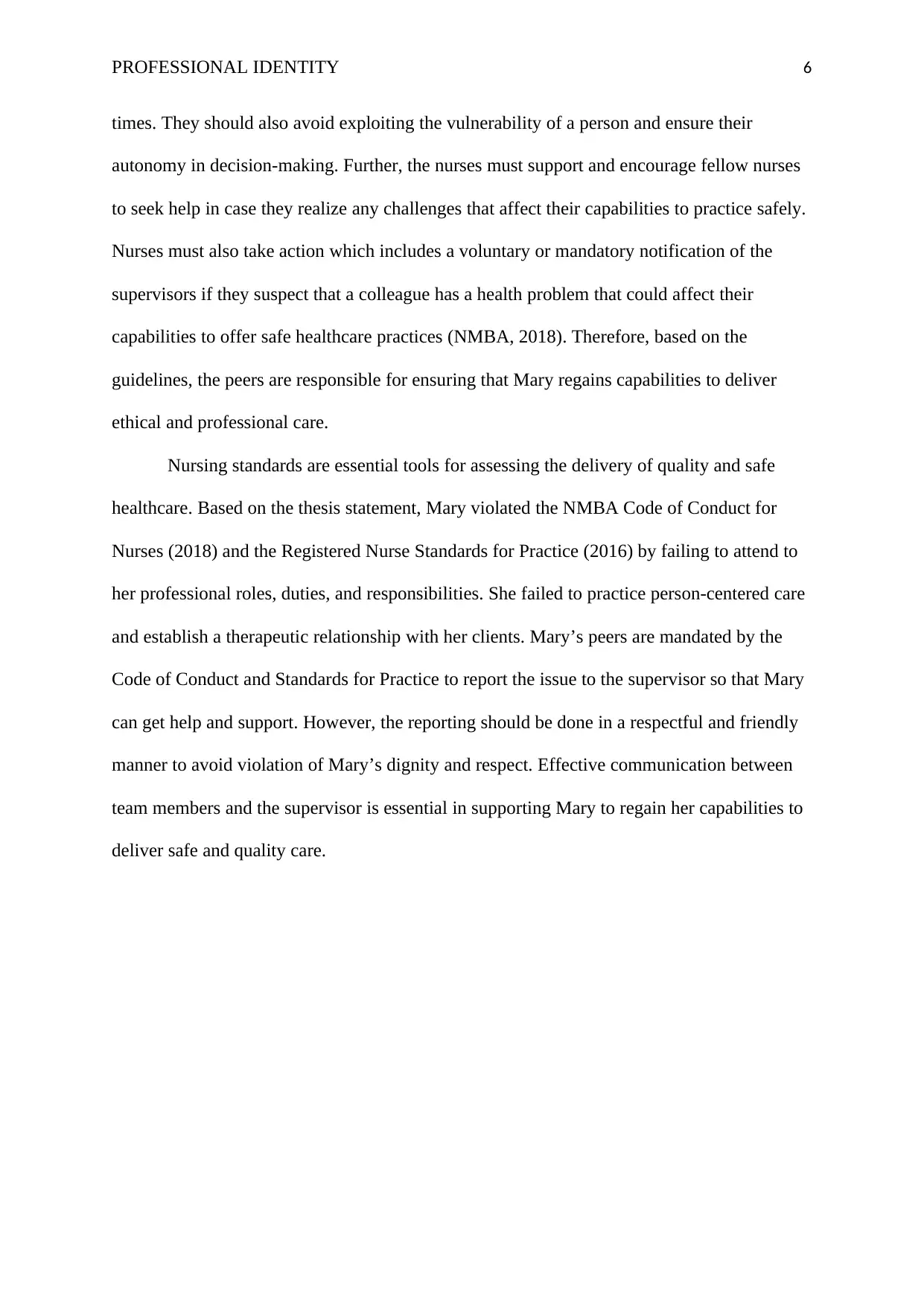
PROFESSIONAL IDENTITY 6
times. They should also avoid exploiting the vulnerability of a person and ensure their
autonomy in decision-making. Further, the nurses must support and encourage fellow nurses
to seek help in case they realize any challenges that affect their capabilities to practice safely.
Nurses must also take action which includes a voluntary or mandatory notification of the
supervisors if they suspect that a colleague has a health problem that could affect their
capabilities to offer safe healthcare practices (NMBA, 2018). Therefore, based on the
guidelines, the peers are responsible for ensuring that Mary regains capabilities to deliver
ethical and professional care.
Nursing standards are essential tools for assessing the delivery of quality and safe
healthcare. Based on the thesis statement, Mary violated the NMBA Code of Conduct for
Nurses (2018) and the Registered Nurse Standards for Practice (2016) by failing to attend to
her professional roles, duties, and responsibilities. She failed to practice person-centered care
and establish a therapeutic relationship with her clients. Mary’s peers are mandated by the
Code of Conduct and Standards for Practice to report the issue to the supervisor so that Mary
can get help and support. However, the reporting should be done in a respectful and friendly
manner to avoid violation of Mary’s dignity and respect. Effective communication between
team members and the supervisor is essential in supporting Mary to regain her capabilities to
deliver safe and quality care.
times. They should also avoid exploiting the vulnerability of a person and ensure their
autonomy in decision-making. Further, the nurses must support and encourage fellow nurses
to seek help in case they realize any challenges that affect their capabilities to practice safely.
Nurses must also take action which includes a voluntary or mandatory notification of the
supervisors if they suspect that a colleague has a health problem that could affect their
capabilities to offer safe healthcare practices (NMBA, 2018). Therefore, based on the
guidelines, the peers are responsible for ensuring that Mary regains capabilities to deliver
ethical and professional care.
Nursing standards are essential tools for assessing the delivery of quality and safe
healthcare. Based on the thesis statement, Mary violated the NMBA Code of Conduct for
Nurses (2018) and the Registered Nurse Standards for Practice (2016) by failing to attend to
her professional roles, duties, and responsibilities. She failed to practice person-centered care
and establish a therapeutic relationship with her clients. Mary’s peers are mandated by the
Code of Conduct and Standards for Practice to report the issue to the supervisor so that Mary
can get help and support. However, the reporting should be done in a respectful and friendly
manner to avoid violation of Mary’s dignity and respect. Effective communication between
team members and the supervisor is essential in supporting Mary to regain her capabilities to
deliver safe and quality care.
⊘ This is a preview!⊘
Do you want full access?
Subscribe today to unlock all pages.

Trusted by 1+ million students worldwide
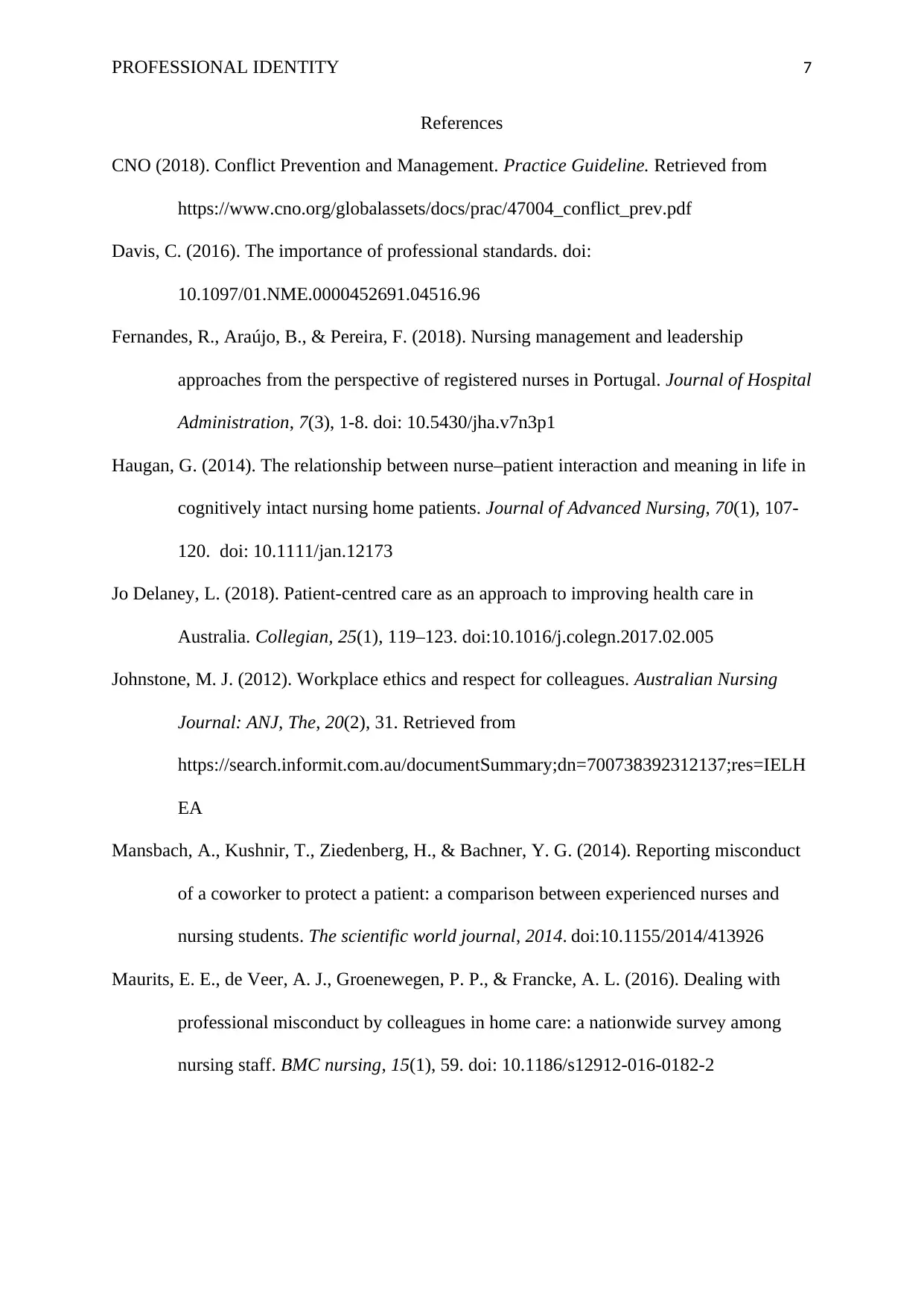
PROFESSIONAL IDENTITY 7
References
CNO (2018). Conflict Prevention and Management. Practice Guideline. Retrieved from
https://www.cno.org/globalassets/docs/prac/47004_conflict_prev.pdf
Davis, C. (2016). The importance of professional standards. doi:
10.1097/01.NME.0000452691.04516.96
Fernandes, R., Araújo, B., & Pereira, F. (2018). Nursing management and leadership
approaches from the perspective of registered nurses in Portugal. Journal of Hospital
Administration, 7(3), 1-8. doi: 10.5430/jha.v7n3p1
Haugan, G. (2014). The relationship between nurse–patient interaction and meaning in life in
cognitively intact nursing home patients. Journal of Advanced Nursing, 70(1), 107-
120. doi: 10.1111/jan.12173
Jo Delaney, L. (2018). Patient-centred care as an approach to improving health care in
Australia. Collegian, 25(1), 119–123. doi:10.1016/j.colegn.2017.02.005
Johnstone, M. J. (2012). Workplace ethics and respect for colleagues. Australian Nursing
Journal: ANJ, The, 20(2), 31. Retrieved from
https://search.informit.com.au/documentSummary;dn=700738392312137;res=IELH
EA
Mansbach, A., Kushnir, T., Ziedenberg, H., & Bachner, Y. G. (2014). Reporting misconduct
of a coworker to protect a patient: a comparison between experienced nurses and
nursing students. The scientific world journal, 2014. doi:10.1155/2014/413926
Maurits, E. E., de Veer, A. J., Groenewegen, P. P., & Francke, A. L. (2016). Dealing with
professional misconduct by colleagues in home care: a nationwide survey among
nursing staff. BMC nursing, 15(1), 59. doi: 10.1186/s12912-016-0182-2
References
CNO (2018). Conflict Prevention and Management. Practice Guideline. Retrieved from
https://www.cno.org/globalassets/docs/prac/47004_conflict_prev.pdf
Davis, C. (2016). The importance of professional standards. doi:
10.1097/01.NME.0000452691.04516.96
Fernandes, R., Araújo, B., & Pereira, F. (2018). Nursing management and leadership
approaches from the perspective of registered nurses in Portugal. Journal of Hospital
Administration, 7(3), 1-8. doi: 10.5430/jha.v7n3p1
Haugan, G. (2014). The relationship between nurse–patient interaction and meaning in life in
cognitively intact nursing home patients. Journal of Advanced Nursing, 70(1), 107-
120. doi: 10.1111/jan.12173
Jo Delaney, L. (2018). Patient-centred care as an approach to improving health care in
Australia. Collegian, 25(1), 119–123. doi:10.1016/j.colegn.2017.02.005
Johnstone, M. J. (2012). Workplace ethics and respect for colleagues. Australian Nursing
Journal: ANJ, The, 20(2), 31. Retrieved from
https://search.informit.com.au/documentSummary;dn=700738392312137;res=IELH
EA
Mansbach, A., Kushnir, T., Ziedenberg, H., & Bachner, Y. G. (2014). Reporting misconduct
of a coworker to protect a patient: a comparison between experienced nurses and
nursing students. The scientific world journal, 2014. doi:10.1155/2014/413926
Maurits, E. E., de Veer, A. J., Groenewegen, P. P., & Francke, A. L. (2016). Dealing with
professional misconduct by colleagues in home care: a nationwide survey among
nursing staff. BMC nursing, 15(1), 59. doi: 10.1186/s12912-016-0182-2
Paraphrase This Document
Need a fresh take? Get an instant paraphrase of this document with our AI Paraphraser
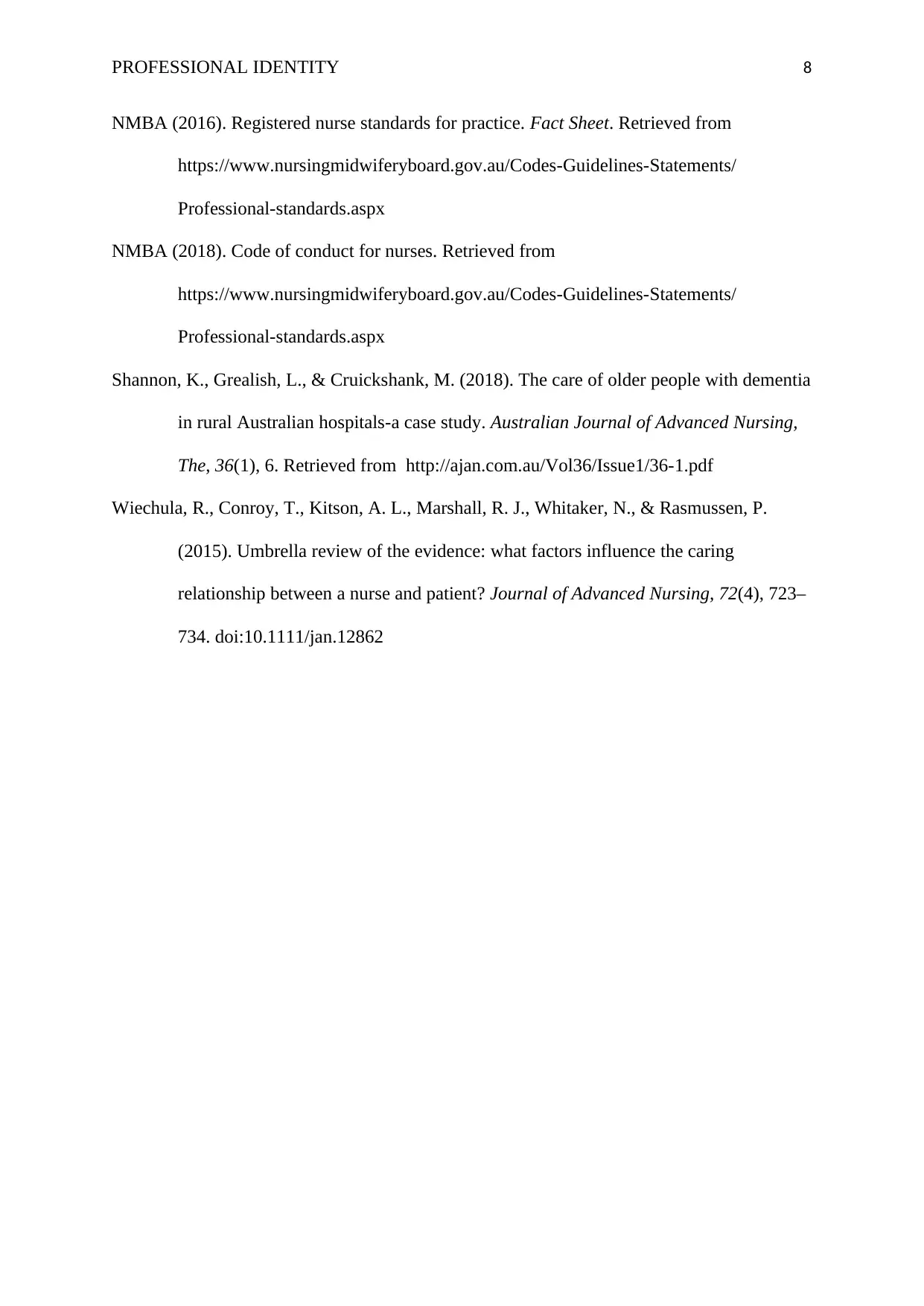
PROFESSIONAL IDENTITY 8
NMBA (2016). Registered nurse standards for practice. Fact Sheet. Retrieved from
https://www.nursingmidwiferyboard.gov.au/Codes-Guidelines-Statements/
Professional-standards.aspx
NMBA (2018). Code of conduct for nurses. Retrieved from
https://www.nursingmidwiferyboard.gov.au/Codes-Guidelines-Statements/
Professional-standards.aspx
Shannon, K., Grealish, L., & Cruickshank, M. (2018). The care of older people with dementia
in rural Australian hospitals-a case study. Australian Journal of Advanced Nursing,
The, 36(1), 6. Retrieved from http://ajan.com.au/Vol36/Issue1/36-1.pdf
Wiechula, R., Conroy, T., Kitson, A. L., Marshall, R. J., Whitaker, N., & Rasmussen, P.
(2015). Umbrella review of the evidence: what factors influence the caring
relationship between a nurse and patient? Journal of Advanced Nursing, 72(4), 723–
734. doi:10.1111/jan.12862
NMBA (2016). Registered nurse standards for practice. Fact Sheet. Retrieved from
https://www.nursingmidwiferyboard.gov.au/Codes-Guidelines-Statements/
Professional-standards.aspx
NMBA (2018). Code of conduct for nurses. Retrieved from
https://www.nursingmidwiferyboard.gov.au/Codes-Guidelines-Statements/
Professional-standards.aspx
Shannon, K., Grealish, L., & Cruickshank, M. (2018). The care of older people with dementia
in rural Australian hospitals-a case study. Australian Journal of Advanced Nursing,
The, 36(1), 6. Retrieved from http://ajan.com.au/Vol36/Issue1/36-1.pdf
Wiechula, R., Conroy, T., Kitson, A. L., Marshall, R. J., Whitaker, N., & Rasmussen, P.
(2015). Umbrella review of the evidence: what factors influence the caring
relationship between a nurse and patient? Journal of Advanced Nursing, 72(4), 723–
734. doi:10.1111/jan.12862
1 out of 8
Related Documents
Your All-in-One AI-Powered Toolkit for Academic Success.
+13062052269
info@desklib.com
Available 24*7 on WhatsApp / Email
![[object Object]](/_next/static/media/star-bottom.7253800d.svg)
Unlock your academic potential
Copyright © 2020–2025 A2Z Services. All Rights Reserved. Developed and managed by ZUCOL.





